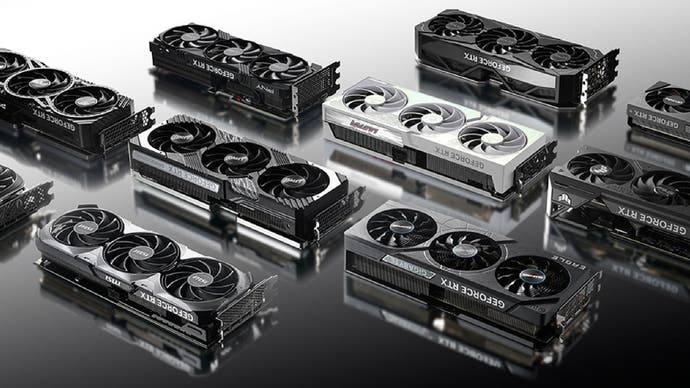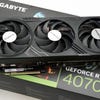Nvidia GeForce RTX 4070 Ti review: a next-gen GPU that's worth the asking price?
Faster than RTX 3080 with more memory, increased efficiency and DLSS 3.
The next generation GPUs from Nvidia - and, as it turns out, AMD - have had a problem: pricing, or rather relative pricing. The issue is that with the Radeon RX 6800 XT and more so the GeForce RTX 3080, we've had GPUs that struck an excellent balance between price vs performance. Both were cut down compared to flagship models, but each retained the bulk of their gaming prowess. For whatever reason, their recently released equivalents - RTX 4080 and RX 7900 XT - have not been able to match the same sweetspot in 'frames for the dollar'. The new RTX 4070 Ti goes some way to addressing this, but still hammers home the point that extra performance and big price reductions are things of the past.
That said, the renamed RTX 4080 12GB does finally address the value challenge of the RTX 3080 to a certain extent. With a confirmed MSRP of $799/£799 - $100/£150 up on the RTX 3080 - you are getting value from the extra cash. Performance of the card is typically in RTX 3090 to RTX 3090 Ti territory. You're getting an extra two gigabytes of framebuffer memory. On top of that, there's DLSS 3, which hasn't yet established itself as the game-changer that DLSS 2 is, but is swiftly becoming very useful - game-changingly so in the case of The Witcher 3: Complete Edition.
That $799 MSRP - down from the $899 of the 'unlaunched' RTX 4080 12GB - is reliant on third-party partner designs arriving at Nvidia's suggested price-point, however. This time there are no Founders Edition cards, which is a bit of a disappointment. Third-party cards seem to be dominated by unnecessarily massive designs, and that extends to the Gigabyte OC model we were sent for review from Nvidia. For a card that offers 50 to 55 percent of the RTX 4090's performance under extreme RT workloads, the card we have is significantly larger than the flagship's already massive design. We can only wish for a form-factor similar to the last-gen RTX 3070 Ti, which deals with similar power throughput in a much more compact design.
| RTX 4090 24GB | RTX 4080 16GB | RTX 4070 Ti 12GB | |
|---|---|---|---|
| Processor | AD102 | AD103 | AD104 |
| Transistors | 76.3B | 45.9B | 35.8B |
| Die Size | 608mm² | 379mm² | 295mm² |
| CUDA Cores | 16384 | 9728 | 7680 |
| Boost Clock | 2.52GHz | 2.51GHz | 2.61GHz |
| Memory Interface | 384-bit | 256-bit | 192-bit |
| Memory Bandwidth | 1018GB/s | 742GB/s | 557GB/s |
| TGP | 450W | 320W | 285W |
| PSU Recommendation | 850W | 750W | 700W |
| PSU Cables | 4x 8-pin | 3x 8-pin | 2x 8-pin |
| Base Price | $1499/£1649 | $1199/£1199 | $799/£799 |
| Release date | October 12th, 2022 | November 16th, 2022 | January 5th, 2023 |
The table above demonstrates how the RTX 4070 Ti fits into the line-up and you may have noticed that we are seeing a very different processor to its more expensive counterparts. The RTX 3080 shared the same chip as RTX 3080 Ti, 3090 and 3090 Ti, but we're looking at a much more varied silicon line-up this time. The RTX 4070 Ti uses AD104, which offers around 47 percent of the compute silicon as the RTX 4090 (albeit at a slightly faster clock speed), half the memory bandwidth and half the framebuffer memory. The AD103 processor used in RTX 4080 is like a halfway house then, slotting in accordingly in terms of specs and indeed flat-out performance.
These specs have caused some concern, as mapping equivalent silicon comparisons to the RTX 3000 product line gives you a product more in line with the RTX 3060 Ti, as opposed to a 70-class GPU. While a valid point from this perspective, it fails to factor in architectural improvements that the Ada Lovelace architecture has delivered - a design necessity bearing in mind how much more expensive TSMC's latest process nodes are. As it stands, RTX 3060 Ti effectively replaced 2080 Super, while RTX 3070 matched 2080 Ti. This time around, 4070 Ti is more in line with RTX 3090 and 3090 Ti.
You may be wondering what the 'OC' element of the Gigabyte model adds to the equation, but it turns out to be a mere +30MHz to the boost clock - insignificant for a card that routinely runs at around 2.8GHz. I would have much preferred a product offering reference clocks, reference TGP and a form factor similar to the RTX 3070 Ti or RTX 3080 Founders Edition models, so hopefully we'll see those in the launch line-up too.
As it is, there are few surprises with the card outside of its gigantic form-factor. There's the standard arrangement of three DisplayPort 1.4a outputs alongside HDMI 2.1 - a perfectly adequate line-up despite the exclusion of DisplayPort 2.1 - while power is delivered by the same 12VHPWR socket used on RTX 4080 and RTX 4090. The difference here is that as the power requirement is much lower, only two eight-pin PCIe cables are required, attached to the GPU via a two-socket dongle. While realising that a new power connector is going to be required at some point, I would have preferred standard PCIe power inputs for a card of this level.
While there's been a lot of controversy around Nvidia's latest GPU line-up, one element of the design that has received plenty of praise has been the Ada Lovelace architecture and its power efficiency. To put this to the test with the RTX 4070 Ti, I repeated the game benchmarks I used in the RX 7900 XTX and RX 7900 XT reviews.
In Control and Dying Light 2 running in RT modes, and using Forza Horizon 5 and Hitman 3 for rasterisation tests, we measure performance and power consumption. By dividing Watts by frame-rate, we can calculate joules per frame - and the lower it is, the better. There are many ways to measure efficiency. Some prefer to measure total system power from the wall (which is perfectly valid), while others measure power consumption with a set frame-rate limit. We prefer our technique as it ensures that the GPU is running flat-out - something that a frame-rate limit won't do.
In the table below, you'll see how RTX 4070 Ti stack up against the RTX 3080 it effectively replaces, while you'll also see comparison data against AMD's RX 7900 XT and the more expensive, more performant RTX 4080. Typically, the lower down the GPU stack you go, the more efficiency you see. However, that's not the case here. While we're still seeing big improvements to power consumption against RTX 3080 and even RX 7900 XT, all of our measurements show the more expensive RTX 4080 to be more efficient - perhaps down to the new card's higher boost clock.
| Radeon RX 7900 XT | GeForce RTX 3080 | GeForce RTX 4070 Ti | GeForce RTX 4080 | |
|---|---|---|---|---|
| Control, 4K, High RT | 305W/30fps - 10.2 Joules Per Frame | 315W/31fps - 10.2 Joules Per Frame | 259W/34fps - 7.62 Joules Per Frame | 302W/44fps - 6.86 Joules Per Frame |
| Dying Light 2, 4K, Ultra RT | 306W/30fps - 9.0 Joules Per Frame | 311W/33fps - 9.42 Joules Per Frame | 261W/39fps - 6.69 Joules Per Frame | 301W/50fps - 6.02 Joules Per Frame |
| Forza Horizon 5, 4K, Extreme, RT Off | 302W/100fps - 3.02 Joules Per Frame | 296W/79fps - 3.74 Joules Per Frame | 203W/100fps - 2.03 Joules Per Frame | 224W/121fps - 1.85 Joules Per Frame |
| Hitman 3, 4K, Max, RT Off | 309W/175fps - 1.77 Joules Per Frame | 314W/109fps - 2.88 Joules Per Frame | 269W/135fps - 1.99 Joules Per Frame | 301W/181fps - 1.66 Joules Per Frame |
Control is an interesting case in that it's a bit of a 'banana skin' game that has scalability issues on the Ada Lovelace architecture. The faster the card, the more performance - relatively - you get. Even so, the new offering has higher performance than RTX 3080 and a 25 percent power-per-frame reduction - but interestingly, the RTX 4080 has a 10 percent advantage over the RTX 4070 Ti judged by the same metrics.
The RTX 4080 is always more efficient in all of our tests. In Dying Light 2, the RTX 4070 Ti offers up a 29 percent per-frame power reduction up against RTX 3080. However, the 4080 once again has a circa 10-percent power-per-frame advantage over its smaller counterpart. In both of these RT tests, the RX 7900 XT is more comparable with Nvidia's last-gen architecture - which is perhaps to be expected, bearing in mind how AMD has effectively delivered RT performance in line with older GeForce cards.
Looking at our rasterisation tests, Forza Horizon 5 continues to fascinate by using power that's nowhere near the TGP limits of the Ada Lovelace cards, producing fantastic efficiency. Yes, RTX 4080 still has that circa 10 percent point lead over the RTX 4070 Ti, but the new card slashes the power-per-frame requirement by 46 percent up against RTX 3080. The 4070 Ti only requires 67 percent of the power to generate a frame up against RX 7900 XT - which is perhaps to be expected as somewhat weirdly, Forza Horizon 5 isn't especially performant on the RDNA 3 architecture.
That's not the case with Hitman 3, where RDNA 3 is blazingly fast, delivering its only win against the RTX 4070 Ti. Nvidia's latest requires 12 percent more power per frame, but both of the latest offerings don't touch the RTX 4080. Even so, the RTX 4070 Ti still has a 31 percent power-per-frame reduction compared to the RTX 3080.
As you may have gathered from the size of this seven page review, we've got plenty of benchmarks to share, but before we kick off, here's a quick outline of the new PC we've built to help test this new generation of GPUs. Sitting at the heart of our system is an Intel Core i9 12900K, running with P-cores at 5.2GHz and E-cores at 3.9GHz. The CPU is augmented with 6000MT/s Trident Z5 RGB DDR5 memory from G-Skill. The Noctua NH-D15 is our cooler of choice for handling the powerful processor, while all titles are run from PCIe Gen 3 NVMe SSDs. All components are mounted in an Asus ROG Maximus Hero Z690 motherboard, while power is supplied by a Corsair RM1000i power supply.
Nvidia GeForce RTX 4070 Ti analysis
- Introduction, hardware and power analysis [This Page]
- RT benchmarks: Dying Light 2, Cyberpunk 2077, Control, F1 22
- RT benchmarks: Hitman 3, Metro Exodus Enhanced Edition, Marvel's Spider-Man Remastered
- RT/DLSS vs FSR2 benchmarks: Cyberpunk 2077, Dying Light 2, Marvel's Spider-Man Remastered
- Game benchmarks: Control, Cyberpunk 2077, F1 22
- Game benchmarks: Hitman 3, Forza Horizon, Red Dead Redemption 2, Shadow of the Tomb Raider
- Nvidia GeForce RTX 4070 Ti: the Digital Foundry verdict











